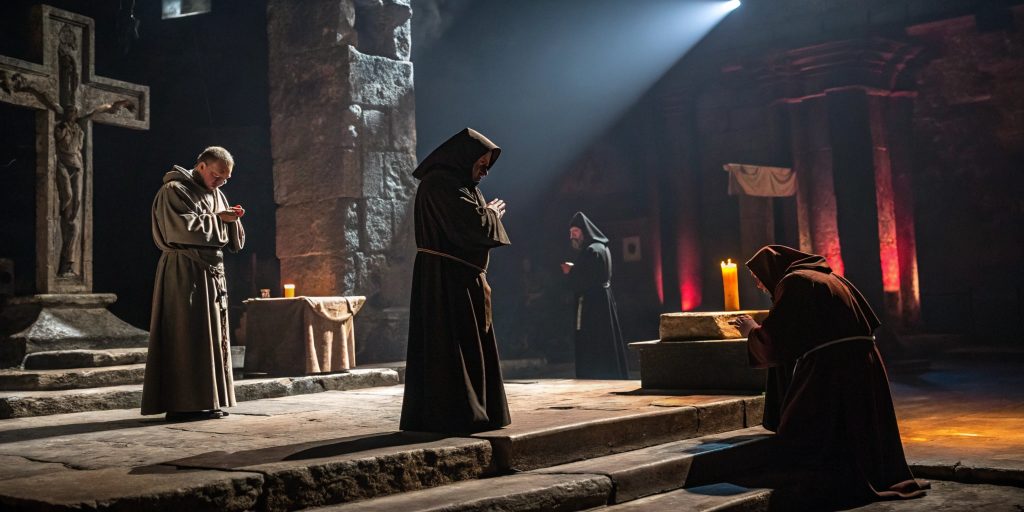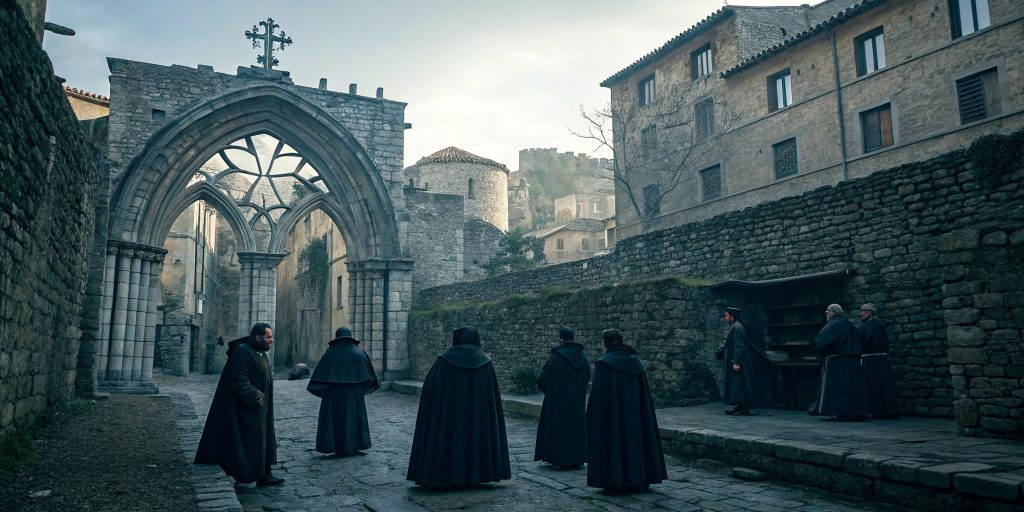To grasp what a friar meant in medieval times, we must look at their role in the Middle Ages. The term “medieval friar” refers to members of mendicant orders who lived for religious zeal and helping others.
Unlike hidden monks, friars worked with groups like the Templar Knights and the Roman Catholic Church. They mixed faith with military duties, often preaching sermons to inspire their followers. This part will show how important friars were in medieval society, particularly through their connections to various orders like the Carmelites and Augustinians. They played a key role in the Church and the community.
Understanding the Role of Friars in Medieval Society
Friars played a big role in medieval society, often seen as the bridge between the clergy and the laity. They were part of religious orders that helped communities. They made spirituality real for everyone.
Friars worked in many areas:
- Spiritual Education: They taught people of all ages about religion.
- Social Welfare: They helped the poor and sick by starting charities, embodying the spirit of penance.
- Community Service: They worked with people to solve problems and mediate disputes.
Friars could travel and help where needed. They worked outside monasteries, meeting community needs. This showed their importance in the medieval world, as described in Chaucer’s works.
Friars helped shape medieval society. Groups like the Franciscans and Dominicans emerged as significant monastic orders during this period. They each had their mission but worked together, much like the apostolic orders, to help communities.
The Definition of a Friar Middle Ages
So, what did friars do? A friar is someone from a mendicant order that started in the Middle Ages. Friars lived differently than monks, such as the Carmelites, who stayed in cloisters. They worked with the community, serving others and following vows of poverty, chastity, and obedience.
Mendicant orders focused on preaching and helping others. Living in absolute poverty was key for friars, reflecting their commitment to monastic orders. They wanted to show Christ’s teachings and help all people. Their way of life helped them connect with the community and lead spiritually.
What Is a Friar in Medieval Times? A Closer Look
Friars in medieval times come from the Latin word “frater,” meaning brother. This shows their role in society. They were key figures in the Middle Ages, focused on helping others and preaching.
They were different from monks who lived in monasteries. Friars worked in cities, spreading the Christian message.
Origins and Etymology
Friars started because people wanted to help the community more. Unlike monks who studied in monasteries, friars preached in cities. They were both leaders and helpers, important in society, often acting as bishops in their communities.
Differences Between Friars and Monks
Friars and monks had different lives. Friars lived among people, showing faith in action. They helped the poor and solved social problems.
This made friars special in medieval Christianity. They connected with people in a way monks couldn’t, fostering a sense of community akin to the Augustinians and their friars’ approach.
Major Mendicant Orders: Franciscans and Dominicans
Mendicant orders were key to the medieval Church. Franciscans and Dominicans made big impacts. Franciscans, led by St. Francis of Assisi, lived simple lives and helped others. Dominicans, led by St. Dominic, focused on teaching and preaching.

The Franciscan Way of Life
Franciscans love nature and live. They help the poor and show great care for society. They pray deeply and work hard to bring peace to the world.
The Dominican Commitment to Preaching
Dominicans are known for their preaching. They seek truth and share knowledge. They teach the Catholic faith and tackle big issues with wisdom.
Friars and Their Vows of Poverty, Chastity, and Obedience
Friars live by three big vows: poverty, chastity, and obedience. These vows shape their spiritual path and build a community based on faith and simplicity, as outlined in the Oxford Dictionary. They also help the poor. Knowing about these vows helps us understand friar life, their dedication to Christian values, and their role as preachers.
The Importance of Absolute Poverty
Absolute poverty is key for friars. They give up owning things to be with the poor. This vow helps them trust God and serve others, not wealth. It shows a life of connection and following Jesus’ teachings.
Commitment to Chastity and Its Implications
Chastity is crucial for friars, reflecting their monastic commitments. It helps them stay focused on their mission. By not being distracted, they can serve and grow spiritually better. This vow shows how friars, like the Austin Friars, put their community first, improving everyone’s spiritual life.
Where Did Friars Live and Work?
Friars in medieval times lived and worked from place to place, adapting to various communities. They lived in cities and the countryside, each with its own challenges and opportunities. Knowing where friars lived helps us see their big role in spiritual and community life back then.

Urban Friaries vs. Rural Settings
In cities, friars had urban friaries, serving as hermits and community leaders. These were places for preaching and helping the community. They were close to people, offering support and justice.
In the countryside, friars helped with farming and spiritual needs and offered penance. Each place made the friar work differently, showing their ability to adapt.
The Role of Friars in Local Parishes
Friars were key in local parishes, including the Order of Friars Minor and other monastic orders. They were spiritual leaders and connected the church to the community through their sermons. They helped with religious services and everyday life.
In cities or the countryside, friars brought people together, acting as spiritual guides like hermits. Similar to the Augustinians, they showed the importance of belonging and guidance. Their work made medieval life richer spiritually.

